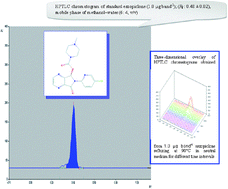An eco-friendly HPTLC method for assay of eszopiclone in pharmaceutical preparation: investigation of its water-induced degradation kinetics
Abstract
An eco-friendly, sensitive and selective high-performance thin-layer chromatographic method was developed and validated for analysis of eszopiclone in bulk powder and formulation. The method employed HPTLC aluminium plates precoated with silica gel 60F-254 as the stationary phase. The solvent system consisted of methanol–water (6 : 4, v/v). Densitometric analysis of eszopiclone was carried out at 300 nm. This system was found to give a compact spot for eszopiclone (Rf value of 0.48 ± 0.02). The proposed method was validated for linearity, precision, robustness, LOD, LOQ, specificity and accuracy in accordance with ICH guidelines. Linearity was found to be in the range of 0.2–1.2 μg per band with a significantly high value of correlation coefficient r = 0.9997. Statistical comparison with a reported reference method showed similar results with respect to accuracy and precision. The study of the eszopiclone water-induced degradation kinetics was carried out by the proposed HPTLC method. The activation energy and degradation rate constant at room temperature were calculated after the construction of the Arrhenius plot.


 Please wait while we load your content...
Please wait while we load your content...